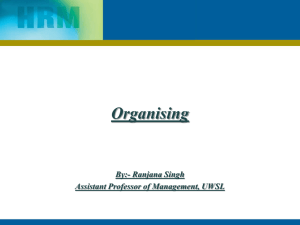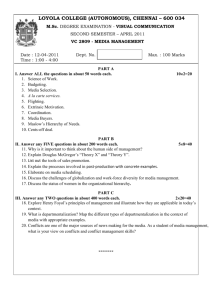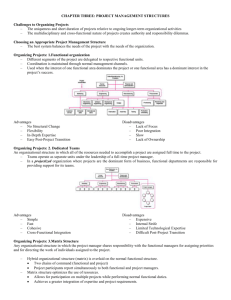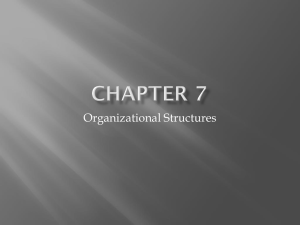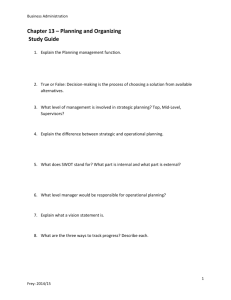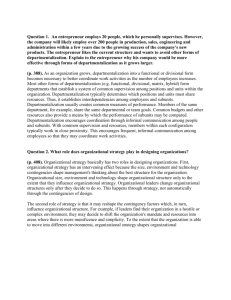Lecture8
advertisement
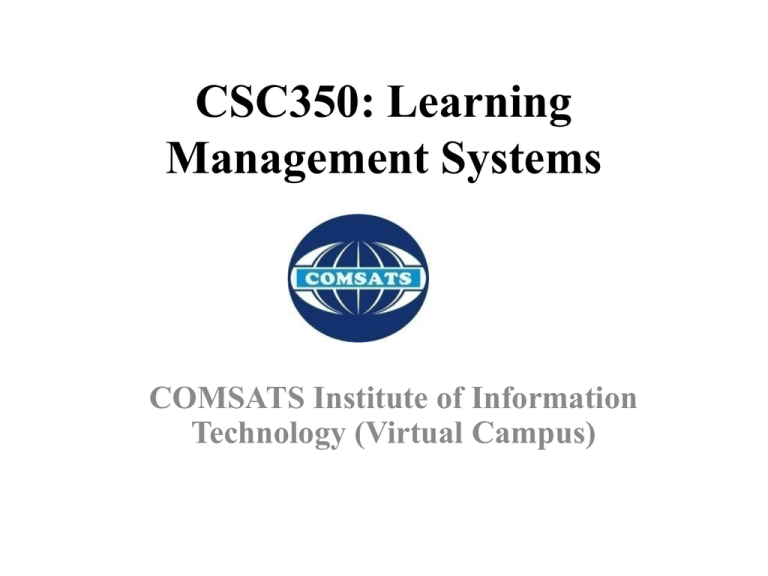
CSC350: Learning Management Systems COMSATS Institute of Information Technology (Virtual Campus) Lecture # 8 Fundamentals of Organizing 2 Review of the Previous Lecture 1. 2. 3. 4. 5. 6. 7. 8. Definitions of strategic planning Main aspects of the strategic management process Key components of environmental analysis Role of organizational direction in strategic management Primary aspects of strategy formulation Importance of strategic control Coordination of tactical planning & strategic planning Competitive dynamics & organization’s financial performance Topics of Discussion 1. An understanding of the organizing function 2. Benefits and costs of bureaucracy 3. Advantages and disadvantages of division of labor 4. Complexities of determining appropriate organizational structure 5. Advantages and disadvantages of departmentalization DEFINITIONS OF ORGANIZING AND ORGANIZATION SKILL • Organizing – Process of establishing orderly uses for resources within the management system • Organizing Skill – Creating a network of people throughout the organization who can help solve implementation problems as they occur • Organization – End result of organizing process Fayol’s Organizing Guidelines Organizing Process CLASSICAL ORGANIZING THEORY • Weber’s Bureaucratic Model: – Detailed procedures and rules – Clearly outlined organizational hierarchy – Impersonal relationships among organization members CLASSICAL ORGANIZING THEORY • Division of Labor: – Assigning various portions of a task among a number of organization members – Advantages: • Specialized skills – Only one job to do – Efficiency – Disadvantages: • Overlooks human variable – Boring – Decreased production Division of Labor & Coordination • Coordination: – Orderly arrangement of group effort – Unity of action – Synchronized order of tasks • Mary Parker Follett Guidelines: – Peer discussion resolves problems – Planned by managers – Maintaining is continuing process STRUCTURE • Designated relationships among organizational resources • Two basic types of structure: – Formal • Represented on organization chart – Informal • Evolves naturally, spontaneously Formal Structure • Organization Chart – Graphic illustration of firm’s organization structure – Pyramid form – Boxes are jobs/positions – Lines designate formal communication lines Vertical Dimensioning • Scalar Relationships – Chain of Command • Unity of Command – Employee reports to only one manager • Span of Management – Number of employees one manager can effectively manage • Height of Organization Chart Horizontal Dimensioning • Lateral subdivisions or specialties • Departments – Unique group of resources established by management to perform organizational tasks TYPES OF DEPARTMENTALIZATION Functional Departmentalization Product/Service Departmentalization Geography Departmentalization Customer Departmentalization Matrix Departmentalization Forces Influencing Formal Structure • Managerial Forces • Task Forces • Environmental Forces • Subordinate Forces Fayol’s Chain of Command Rationale Informal Structure • Mechanistic Structures – Formal organizational structures – Suited for large companies in stable industries • Organic Structures – Less formal – Represent loosely coupled worker networks – Suited for smaller companies in volatile industries Thank You 24
